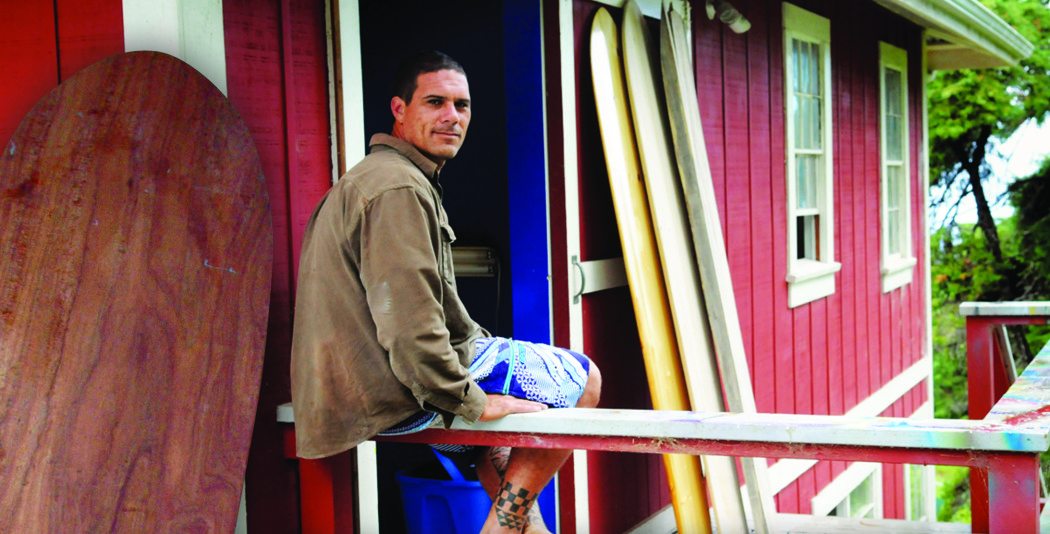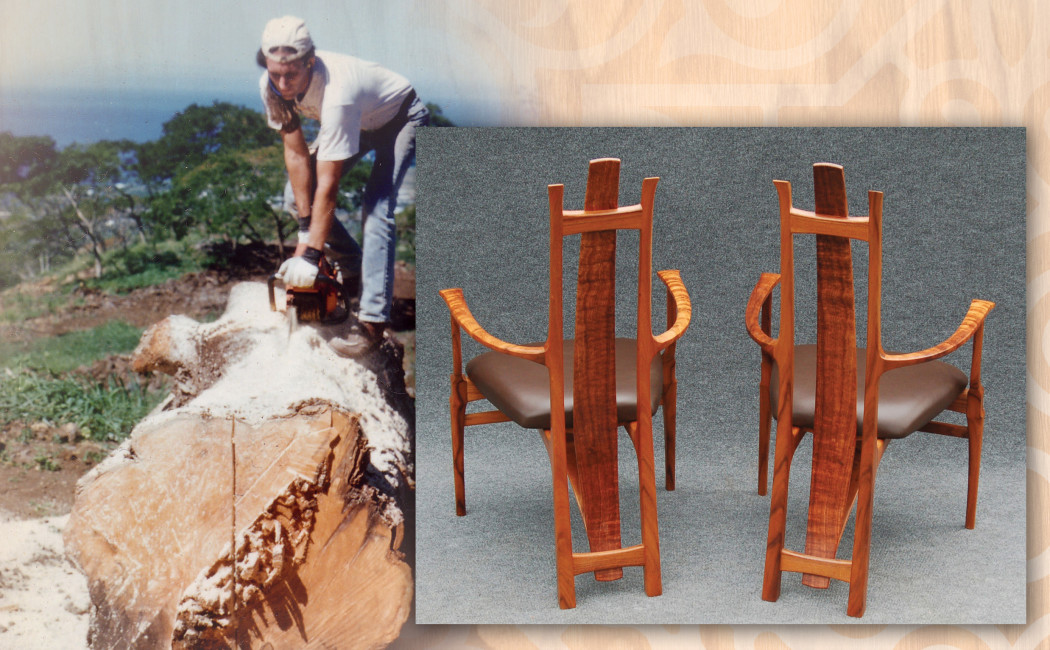
Crafting Hawaiian Woods
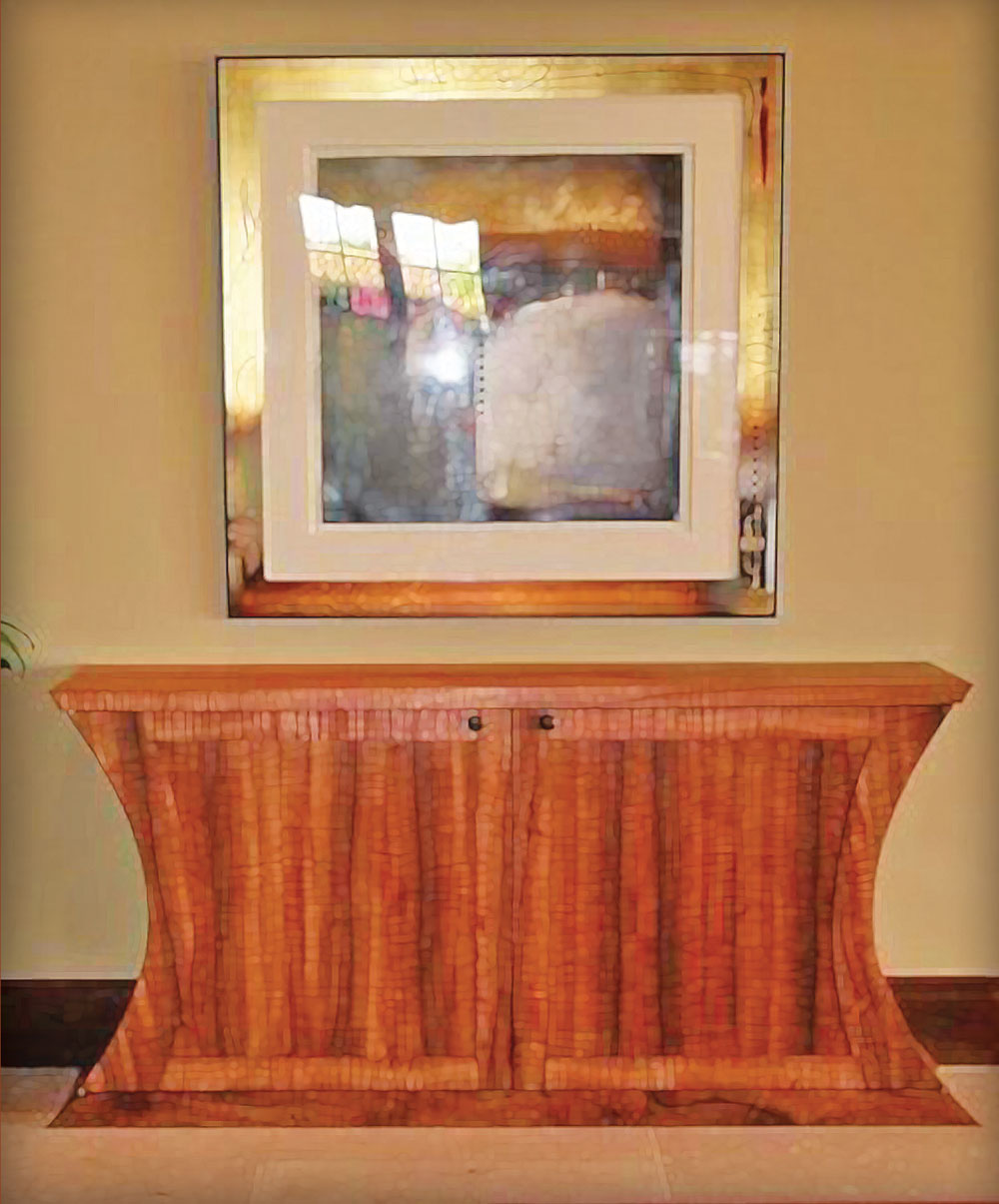 By Denise Laitinen
By Denise Laitinen
Milo. ‘Ohi‘a. Koa. These are just some of the beautiful woods native to our island. As interest surges in using all things local, so does interest in using Hawaiian woods. Big Island woodworkers are turning out dining room sets, rocking chairs, coffee tables, kitchen cabinets, flooring, and bowls using Hawai‘i woods grown on the Big Island.
When people think of Hawaiian wood they tend to think of koa. With color hues ranging from light shades to nearly black, and grains from straight to curly, koa is found only in Hawai‘i.
“Koa is so popular because it’s so beautiful,” says Mike Riley, a master woodworker based in Volcano who’s been using koa for more than 30 years. “There are less than a dozen woods in the world that will curl and koa is one of those woods.”

“You can have a contrast from one piece to another depending on the tree,” he adds. Wood colors vary by tree and by region. Typically, trees from the same forest have a similar shade of color. “Koa grown in Volcano is well known for its red tones,” explains Riley. “South Kona koa tends to have light brown tones, while koa grown in Hamakua is noted for its deep red and brown tones.”
Ancient Hawaiians used koa trees for outrigger canoes. Great care and consideration went into selecting and cutting a tree for a canoe. Today, koa is used for everything from picture frames to side tables. And while koa furniture adds beauty to any home, that beauty comes at a price.
“You can’t just go to the store and get [raw] koa,” says Riley. “The price has skyrocketed in recent decades because of the beauty and scarcity of the wood.”
Koa is one of two species of canopy trees found in the native Hawaiian rainforest (the other canopy tree being ‘ohi‘a). It grows well at the 4,000-6,000-foot elevation and can live for more than 300 years.
At 125 years old, a koa tree is in its prime, whereas trees 200 – 250 years old are considered old-growth koa. While koa trees less than 40 years old can be harvested for use, the wood is still young.
For Riley, a 40-year-old koa tree is too young. “If you use young wood it’s possible that it’ll collapse while it’s being dried or cured. The cell structure hasn’t developed to the point where it can sustain the drying process. And the wood hasn’t developed its full color.” Riley prefers using koa trees at least 125 years old for their woodworking quality and feels the older the tree the better it is to use.
Finding koa trees young or old can be a challenge. Two centuries of logging and cattle grazing have decimated native forests causing mature koa trees to become rare. Old growth koa trees are even rarer. “When an old growth [koa] tree is knocked down in a storm it’s nirvana for a woodworker,” explains Riley. “You know the wood will go through the drying process very well, and you won’t have problems with warping and cracking.” One old-growth koa tree can produce 1,000 board feet of excellent grade lumber. In comparison, a woodworker needs about 200 board feet of wood to make a dining room set.
Riley used to have his choice of old-growth koa trees around the island. “They’re not available anymore,” he says. “They’re all gone now.” What is available today is salvage wood: trees that fall down on private lands and ranches. A large reason for the dearth of old growth trees is the increased demand for koa wood worldwide.
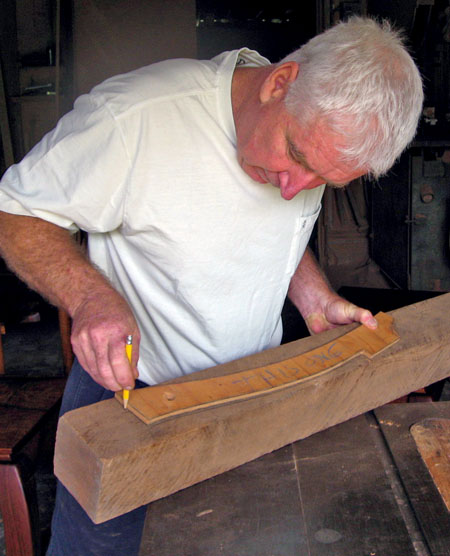
“Twenty-five years ago I was only competing [for wood] with woodworkers in Hawai‘i,” says Riley. “Nowadays I’m competing with a guitar maker in Spain and a cabinetmaker in Boston who want to use koa.”
While koa may be a great choice for many types of home furnishings, it’s not good for everything.
“If you wear high heels on koa floors it will get marked up,” says Riley. “Koa is not an extremely hard wood.” A better flooring choice is ‘ohi‘a, which can be found in abundance around the island. A hard wood with a fine texture, ‘ohi‘a was used by ancient Hawaiians to make poi boards, kapa beaters, decking for canoes, and statues. Compared to koa, ‘ohi‘a has a plain grain to it so it is rarely used for furniture. Rather, it is usually used for flooring, cabinets, and beams.
“‘Ohi‘a floors are very hard, very beautiful floors,” adds Riley. “‘Ohi‘a is a much stronger wood, so it works well for floors.” Some woods, such as Hawaiian milo, used to be common but are now hard to find and therefore used for smaller items, such as bowls or ‘ukuleles. Ancient Hawaiians used native milo to make poi bowls, utensils, and plates because the wood doesn’t contain unpleasant-tasting sap that could contaminate food.
Hawaiian milo is one of the rarest legal woods in the world according to Riley. “Hawaiian milo only grows next to the ocean and since oceanfront property around the state is being developed, it doesn’t have a place to grow.”
“People buy oceanfront property and don’t always realize that the wood that grows there is very rare,” says Riley. He recalls an occasion several years ago when he received a pile of milo wood from a fellow on Moloka‘i. A new property owner had acquired beachfront property and, not realizing the lot was filled with rare Hawaiian milo trees, had the land bulldozed to make way for construction.
One of the workers recognized the milo trees and pulled them from the debris. Knowing that Mike Riley was a well-known wood worker, he called Riley and asked if he wanted it. Riley jumped at the chance and the fellow put the wood on a barge to Hilo.
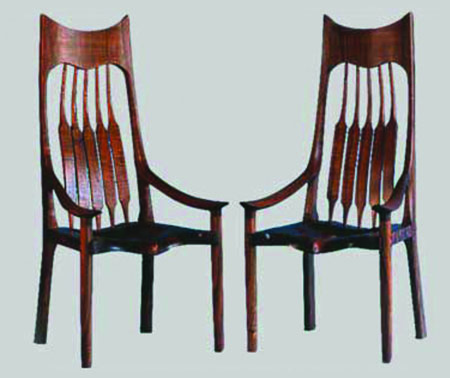 Because Hawaiian woods run the gamut of colors and uses, it comes down to personal taste when selecting home furnishings. How do you incorporate local Hawaiian woods in your home? Do your homework first.
Because Hawaiian woods run the gamut of colors and uses, it comes down to personal taste when selecting home furnishings. How do you incorporate local Hawaiian woods in your home? Do your homework first.
“For some people, they see a piece of furniture or a finely turned bowl and they like the piece,” says Riley. “That’s enough for them.” However, if you’re going to invest thousands of dollars in custom-built furniture, you want to do your research and find a reputable woodworker.
“You should educate yourself,” says Riley. A past president and board member of the Big Island Woodworkers Guild (now the Hawai‘i Wood Guild), Riley suggests checking out the local woodworkers organizations, as well as art galleries to learn about the different artists and woods (see sidebar).
As with anything, you get what you pay for. Established woodworkers are at the top of their field and therefore command top price. If you’re new to the market and don’t have a lot of money, you might want to seek out young, new woodworkers.
How can you tell if someone is a good woodworker? Design and finish are two key aspects. “If you want to judge a woodworker, look at his chairs to see where he’s at,” says Riley. “Chair work is the height of woodworking,” he explains. “The joinery has to be right and the design has to be good.”
Design is key. The difference between average and high-end can be as little as 1/8 inch. That’s why it pays to research woodworkers and their specialties and to check out their previous work.
A wood’s finish is also important. You should ask a woodworker what kind of finish they use. “The finish is a world all its own,” explains Riley. “If I want to protect the wood I use a lacquer finish. If I want to bring out the beauty of the wood, I use oils.”
With some woods, like Hawaiian milo, the true nature of the wood only comes out in the finish process. “A heavy finish on milo will hide its true colors, the color won’t come out,” adds Riley.
How you use the piece also dictates the finish. For instance, if you want a wooden bowl, but you plan on using it to hold fruit, you need to tell the woodworker ahead of time because it will determine what finish is used. “If food is going to be in the bowl, you have to be careful with the finish you use,” explains Riley.
Whether you want to add a small bowl to your home collection or use ‘ohi‘a flooring for your entire house, one thing is certain. There is a native Hawaiian wood that will fit your needs and a local woodworker that can help you meet those needs. ❖
Finding a Woodturner
Woodturners are skilled artists and each has a unique sense of style. Perhaps you’re looking for a certain piece of wood furniture or décor and aren’t sure where to start. The Hawai‘i Wood Guild and wood turners clubs in east and west Hawai‘i Island all have websites featuring members’ works, as well as works featured in previous shows. The websites also provide links to the artists’ respective websites if they have one. Perusing the clubs’ websites lets you quickly check out several artists at once. Bear in mind that the woodturners clubs and guild only feature current members. There are several highly regarded woodturners with decades of experience around the island that may not be a current club member but are featured in local art galleries or on their own websites.vTo find a woodworker in your area, or to learn more about local woodworkers, check out:
- Hawai‘i Wood Guild: a non-profit association of Big Island woodworkers with 34 members run by a volunteer board. In addition to seminars, the guild sponsors an annual juried show of fine woodworking every February. To learn more about Hawai‘i Wood Guild go to www.hawaiiwoodguild.com or email info@hawaiiwoodguild.com.
- Big Island Woodturners: a chapter of the American Association of Woodturners since 1997, the group has 70 members and hosts bimonthly meetings in East Hawai‘i. They sponsor an annual exhibit every March at the Wailoa Center Gallery in Hilo. You can learn more about the Big Island Woodturners Club at bigislandwoodturners.org, or email info@bigislandwoodturners.org.
- West Hawai‘i Woodturners Club: a member of the American Association of Wood. Its 25 members meet bimonthly and many members of the West Hawai‘i club are active in the Big Island Woodturners group as well. For more information on their club, check out www.westhawaiiwoodturners.org or email webmaster@westhawaiiwoodturners.org.
- Contemporary Hawaii Woodworkers, the Wood, the Art, the Aloha, by Tiffany DeEtte Shafto and Lynda McDaniel is a hardcover coffee table book featuring 36 Hawai‘i artists. Published in 2009, all the artists in the book have either received awards in juried shows or judged Hawai‘i fine craft/woodworking exhibitions. The book is published by Contemporary Publications, which was founded by Tiffany DeEtte Shafto, a woodworker who wanted to document and promote the work of local artists. The book is available at area bookstores. The website www.contemporaryhawaiiwoodworkers.com provides links to the various artists featured in the book.
Contact Denise Laitinen at wahineokekai@yahoo.com.
Photos courtesy of Mike Riley.
